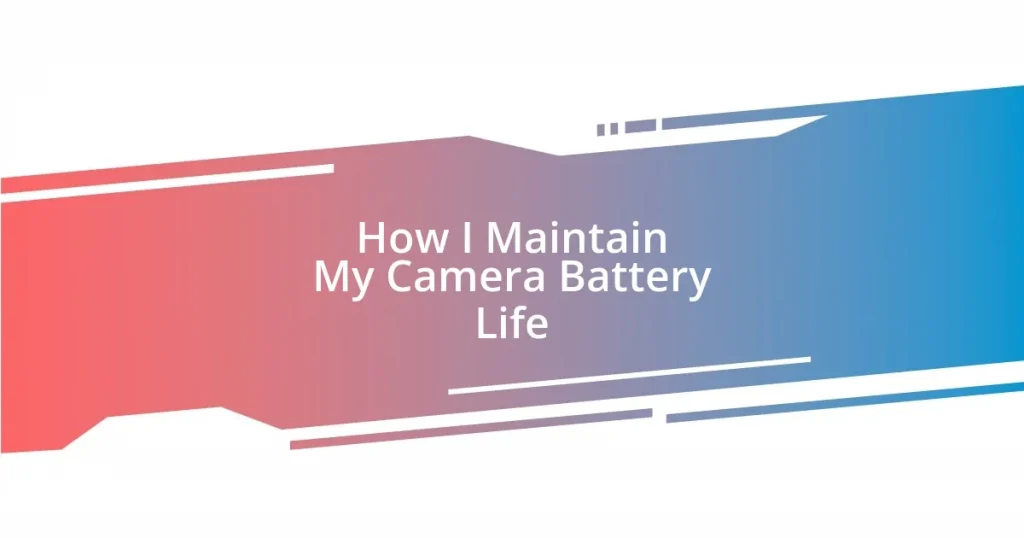Key takeaways:
- Different battery types (e.g., lithium-ion vs. nickel-metal hydride) affect performance; temperature and charging habits also play key roles.
- Intense shooting, extreme temperatures, and active camera features can significantly drain battery life.
- Proper charging techniques, storage practices, and regular battery maintenance extend lifespan and performance.
- Signs for battery replacement include decreased charge retention, physical damage (swelling/leakage), and age (typically 2-3 years for lithium-ion batteries).

Understanding Camera Battery Basics
Understanding the basics of camera batteries is crucial for any photographer. I still remember my first shoot when my battery died mid-session, and I felt that sinking feeling in my stomach. It taught me that knowing how battery types, like lithium-ion versus nickel-metal hydride, can really impact my shooting experience.
Did you know that temperature can affect battery performance? On a chilly day, I’ve noticed my battery drains faster, which is something I wasn’t aware of at first. It’s interesting to think about how we often consider our gear but overlook something as vital as the battery’s environment.
Charging habits also play a key role. I used to leave my battery plugged in overnight, thinking it would help, but I learned that consistently overcharging can shorten battery life. Have you ever experienced a battery that just wouldn’t hold a charge anymore? It’s a frustrating realization that makes me more mindful of how I care for my equipment.

Factors Affecting Battery Life
I’ve come to realize that several factors significantly impact how long my camera battery lasts. One of the biggest culprits is the type of shooting I’m doing. When I do a high-intensity shoot, such as a fast-paced event, I can easily drain my battery in no time. I’ve often been in situations where I had to swap batteries between shots, sparking a sense of urgency that really gets my adrenaline going.
Temperature fluctuations have also become a fascinating aspect of my shooting routine. I clearly remember a summer wedding where the heat was sweltering—my battery was draining much faster than usual. I even had to take a moment to find a shady spot for my gear, knowing that protecting my battery from overheating would extend its life. It was a great reminder that every little detail matters in photography!
Finally, the features I use on my camera can greatly influence battery life. I’ll admit that I have a tendency to rely heavily on features like Wi-Fi and image stabilization. On one memorable outing, I forgot to turn off the Wi-Fi after capturing shots for social media, which resulted in my battery running empty before I could capture those golden hour moments. I learned a valuable lesson about being mindful of my settings and actively managing them to preserve battery life.
| Factor | Impact on Battery Life |
|---|---|
| Shot Intensity | High intensity drains battery quickly |
| Temperature | Extreme heat or cold affects performance |
| Camera Features | Active features like Wi-Fi consume power |

Tips for Extending Battery Life
It’s all about those little adjustments that can make a world of difference in extending my camera battery life. I remember a day where I went out for a hike, all excited to snap some landscapes, only to have my battery die halfway through. It was such a letdown! Since then, I’ve made it a point to adopt habits that protect my battery juice.
Here are some tips I’ve found effective:
- Keep your battery cool: I always try to keep my camera in a shaded area or a cool bag. When I forget, I can almost feel the battery’s life slipping away as it overheats.
- Turn off unnecessary features: Features like Wi-Fi and GPS can drain the battery quickly. I’ve learned to switch them off when I’m not using them. It’s a small effort but goes a long way.
- Use power-saving modes: Most cameras offer energy-saving modes. When I remember to switch these on during long sessions, I’m pleasantly surprised at how much longer my battery lasts.
- Carry a spare: After that hiking disaster, I always make sure to have an extra battery on hand. It gives me peace of mind to know that I can keep shooting without interruption.
I’ve also discovered that adjusting my screen brightness helps preserve battery life. If I’m outside, I usually dim it down; I still remember squinting at a bright screen while trying to focus my shot. The struggle was real, and so was the wasted battery! Now, I make sure to tweak the settings to keep shooting longer and capture those unforgettable moments.

Proper Charging Techniques
When it comes to charging my camera battery, I’ve learned that using the right techniques makes all the difference. For instance, charging slowly with a dedicated charger has become my go-to method. I vividly remember the first time I rushed the process with a quick charger, only to realize my battery’s overall health decreased over time. Those moments of impatience can cost you in the long run, right?
I also pay attention to the battery’s charge levels before storing it. I try to avoid keeping it at a full charge for extended periods. After years of trial and error, I’ve found that maintaining a charge between 40% and 60% helps prolong its lifespan significantly. Reflecting on this habit, I can’t help but wonder how many photographers overlook the simple act of proper storage!
Lastly, I’m always mindful of using compatible charging equipment. Remember that one trip where I borrowed a charger from a friend that was meant for a different camera? My heart sank when I realized my battery didn’t like it and refused to charge. It was a frustrating situation, and I can assure you, there’s nothing worse than being caught with a dead battery when you need it most.

Best Storage Practices for Batteries
When it comes to storing my camera batteries, I’ve learned that a cool, dry place is key. I always keep mine in a small, insulated bag, ideally at room temperature. I once left a battery in my car on a hot summer day, and I could almost hear its life flashing away. That was a hard lesson—I can’t stress enough how temperature extremes can impact battery performance.
Another practice I find crucial is to keep the battery contacts clean. A quick wipe with a microfiber cloth every few months helps maintain a solid connection. I remember a frustrating afternoon when my camera wouldn’t power on because of corrosion on the contacts. It left me wondering how many other photographers face this issue without realizing it. A little upkeep can save a lot of heartache.
I also make it a habit to rotate my batteries regularly. It might seem simple, but I believe it ensures that all my batteries remain in good condition. There was a time when I left one battery stored for months without using it, only to discover it had lost its charge completely. Now, I set reminders to cycle through them, which has significantly extended their life and kept my shoots running smoothly. Isn’t it amazing how something so small can make such a big difference in our creative endeavors?

When to Replace Your Battery
When it comes to battery replacement, I’ve learned to recognize a few tell-tale signs that suggest it might be time to invest in a new one. For instance, if I notice that my camera isn’t holding a charge as long as it used to, that’s a big red flag for me. I recall a shoot where my battery plummeted from full to empty in just a couple of hours, leaving me scrambling for backup. It was a hectic moment that taught me to keep a keen eye on performance.
Another clear indicator is physical changes to the battery itself. If I see any swelling or leakage, I know it’s time to say goodbye. I remember one time I pulled out a battery only to find it had an odd bulge; that was my cue to dispose of it safely. It’s disheartening to think that a small oversight like that could potentially ruin an entire project. Have you experienced a similar situation where a trusting glance led to disaster?
Lastly, I recommend monitoring the age of the battery. Most lithium-ion models, which I frequently use, tend to last about two to three years before their performance degrades. I once had a battery that started showing signs of age around the two-year mark, and I should have replaced it sooner. Delaying this can not only lead to frustrating moments but can also affect image quality due to inconsistent power supply. Have you considered how long you’ve had your batteries? Sometimes, just a simple check can save us significant headaches during our creative pursuits.















